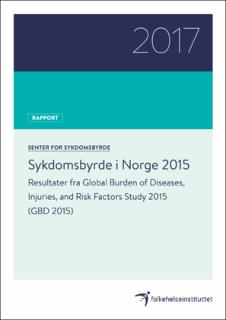| dc.description.abstract | Introduction
Disease burden estimates describe how diseases, injuries and risk factors affect the mortality and disability in a population. The comparison of the disease burden in different groups of the population is central in the estimations. The Global Burden of Disease project (GBD) is a large epidemiological project aimed at identifying and describing the main drivers of fatal and non-fatal health loss at global, regional, national, and, in some cases, subnational levels. The project is coordinated from the Institute for Health Metrics and Evaluations (IHME) in Seattle, United States. GBD describes the development in disease burden for more than 300 health conditions and almost 80 risk factors for 195 countries. In the autumn 2016 GBD published new global, regional and national estimates of disease burden (GBD 2015), including detailed measures of disease burden in Norway. The present report gives a summary of the Norwegian results.
Methods
The GBD project employs four main measures of disease burden: number of deaths, years of life lost (YLL), years lived with disability (YLD) and disability-adjusted life-years (DALY). Life expectancy and healthy life expectancy are also estimated. YLLs are estimated based on life expectancy at the age of death. Non-fatal health loss (YLD) is estimated by multiplying the prevalence of disease and injuries with their associated health loss, quantified through disability weights. DALY is a summary measure of fatal and non-fatal health loss, and is estimated by summarising the YLLs and YLDs for different health conditions. The data sources used in GBD are collected through systematic searches and literature reviews of health data from sources such as health registries, health surveys and published articles around the world. When data are sparse or missing in a geographical area, the global model in GBD provides estimates from that area based on data from other similar areas. Norwegian estimates are most heavily influenced by data from other Western-European countries.
Results
The GBD 2015 results for Norway show that both life expectancy and healthy life expectancy have increased since 2005. The disease burden in Norway is dominated by non-communicable diseases, both in terms of fatal and non-fatal health loss. The most important causes of death are diseases common in the population 70 years and older, in particular cardiovascular diseases and dementias. Neoplasms (cancer) is the second largest cause of death in the population, and the most important cause of death before age 70. Despite decreasing since 2005, ischemic heart disease (myocardial infarction) is still the largest cause of both number of deaths and YLLs in Norway. Other important contributors to number of deaths and YLLs are cerebrovascular disease (stroke), dementia, lung cancer, colorectal cancer, lower respiratory infection (pneumonia) and chronic obstructive pulmonary disease (copd). Suicide and overdoses are the most common causes of death in the age group 15 to 49 years, and are therefore among the ten largest causes of premature mortality (YLLs). Musculoskeletal and mental disorders are the largest causes of non-fatal health loss (YLDs). Mental disorders cause substantial non-fatal health loss in almost all age-groups, and depressive and anxiety disorders are the most important causes within this group. Low back and neck pain is the largest single cause of disease burden measured as DALYs in the Norwegian population. High blood pressure, unhealthy diet and smoking are the modifiable risk factors that cause the most deaths. Smoking is the most important risk factor for death before the age of 70. The risk factors in GBD explain around half of the deaths, but only 20 % of the non-fatal health loss in Norway.
Discussion
The extensive collection of data sources from all over the world, the quantification of uncertainty and the effort to maximize comparability over time, geographical area and across different health conditions are the main strengths of the GBD project. GBD also contributes to identifying areas with sparse or missing information. For instance, there are large differences in the amount of disease burden that is explained by the included risk factors in GBD. While 85 % of the disease burden due to cardiovascular diseases is attributed to the GBD risk factors, they only explain about 20 % of the disease burden due to musculoskeletal and mental disorders.
Missing and sparse data, and varying quality of the data are the major challenges for the validity of the GBD results. This also applies to data from high income countries such as Norway. There is little tradition for systematic data-collection on many non-fatal health conditions, such as mental and drug use disorders, and the prevalence and distribution of these in the Norwegian population are not known. Norway also lacks a system for regular collection of national representative data on prevalence of important risk factors, such as alcohol use, diet, high cholesterol, high blood pressure and low physical activity. To improve the quality of the Norwegian estimates, it is essential that health conditions and risk factors that are important for the Norwegian disease burden are regularly assessed in the Norwegian population.
Conclusion
The results from the GBD-project provide a comprehensive and comparative overview of fatal and non-fatal disease burden over time and across sex and age groups in the Norwegian population. The project also estimates the contribution from important risk factors on public health. The results may inform the knowledgebase and discussions on public health issues in Norway. | |
